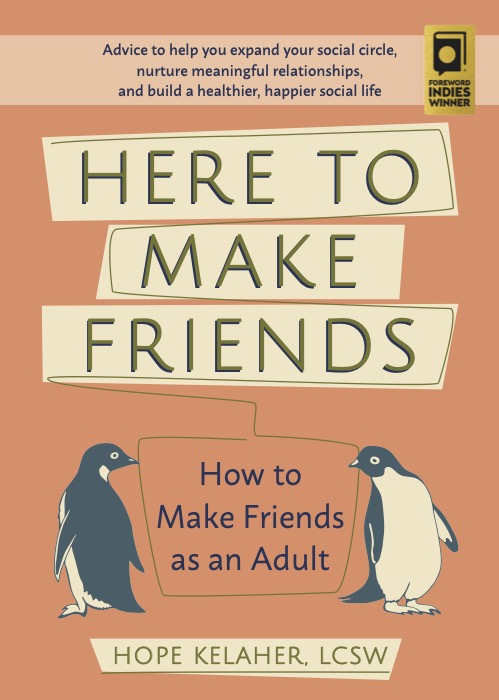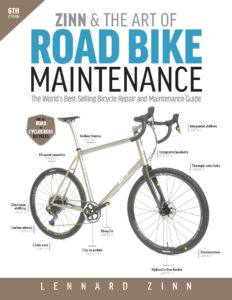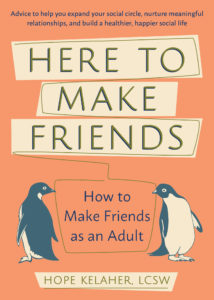
How to Make Friends As An Adult
- Self-Help
How to Make Friends As An Adult
This article was adapted from Hope Kelaher‘s book Here to Make Friends
Making Connections
Whether you are working to find new friends, maintain the old ones, or eliminate some toxic friendships—it’s time to start your journey. The best part is, no matter your starting point, you don’t need to start from scratch. You might have doubts about this, especially if you’ve moved to a new city and are having trouble meeting new folks, but it’s true. With social media and technology doing the networking for us, we are even more connected to “people who know people.” When talking about our own interpersonal connections, we’re likely closer than six degrees of separation!
Examine Your Networks
For some, the following recommendations seem like common sense; for others they may be intimidating, but don’t worry. The first step in making friends, especially if you are struggling, is to examine your current social networks. Review the exercises that asked you to list those you are in contact with and those you would like to be in contact with. Ask yourself if there is any connection between the people you already know and have a rapport with and those you would like to get to know better. Would you ever consider asking an established friend to connect you to a potential friend? Think of it like networking or an informational interview for a job. It’s not a big deal if the connection doesn’t pan out, and at least you can say you tried.
Within our existing networks, we may have people who are really, really good at connecting people. In The Tipping Point, Malcolm Gladwell talks about three different archetypes of people: mavens, salespeople, and connectors. Gladwell considers mavens to be information brokers, those people who openly share what they know to others, and salespeople to be those individuals who are incredibly persuasive and can garner support behind them. For the purposes of this book, we are going to focus on connectors. Although Gladwell emphasized the ways these archetypes promote change, his theory about connectors within social networks applies to how we can make friends. He describes connectors as natural hubs for human resources. If you ask them a question, without thinking, they will recommend someone who knows someone. Connectors are active in our workplace; you just need to assess who these people are in your social networks. You may be able to identify them, as they tend to be more extroverted, love engaging with others, and are able to zoom in to any situation and identify the perfect person for you. Consider that old childhood neighbor who is always eager to set you up with their son/daughter/friend’s son or daughter. Could these people be connectors? You bet!
Interestingly, Gladwell suggests that it is not necessarily our close inner networks (close friends and family) who are the most helpful in building connections, but those acquaintances found within our outer networks. His premise is that the people we meet randomly at a social or work gathering might be more useful to us than those people who know us more. On one hand, this makes sense. Think of the friends you have—you likely spend your free time doing similar things and with the same people. As a result, there’s not a lot of room for new and different people. Those in our outer networks bring forth their different networks, as a result allowing for more access to others. Consider the next time you are at party and find yourself talking with someone new. You may want to show curiosity about who they know. Mention an activity or sport you enjoy and that you are looking for some new companions. I wouldn’t be surprised if they tried to set you up with someone they know right there.
Now the question is: How do you find those superconnectors in your network? While we all have connectors in our networks, consider seeking out those superconnectors, or people in your network who are especially good at not only networking and putting people in touch, but who use their connections to build communities out of their networks. Super-connectors are geniuses at not only knowing who’s in the know, but also fostering authentic relationships with those they know. We know that not all people fall into this archetype, and we wouldn’t want to assume that just because someone is chatty and friendly they are the gatekeeper to our future friendships. Keith Ferrazzi, the author of Never Eat Alone and Other Secrets to Success, One Relationship at a Time, suggests that the best way to find super-connectors is to identify them by their fields of work. For instance, acquaint yourself with people in professions that engage and connect with others. In theory, if you can connect with people like this, they will in turn introduce you to new people. Some of the key connectors to look out for include restaurateurs, publicists, fundraisers, headhunters, and those involved in politics. Other possible super-connectors are those who work in media, Instagram influencers, the local bartender/barista, the PTA president, that person who works from home (or an office share environment like WeWork), attorneys, and salespeople.
You might be thinking: So how do I use this information in my own personal life, and what do I do with it? First, do you happen to have any close friends on your friendship inventory list who have any of the above-mentioned careers? If so, start with them. Ask them if they know of anyone in their network who has interests similar to yours. Would they mind setting up an introduction?
Understandably, it may feel uncomfortable at first to ask this of your network, especially if it is small. However, you have to start somewhere, and the first step is often the scariest. Don’t forget that we have all been in this place at one time or another. Alternatively, you could pursue the larger networks in your world. If you start going to the same coffee shop for a quick break at lunch or have a drink at the same bar, you’ll become a regular. Eventually, the staff will start to recognize you, and conversations will blossom. You will probably meet other regulars as well. Often I hear stories about how someone got a job or an invite to a backyard BBQ simply by going to the same place in the community over and over.
Consider the case of KC, an immigrant who moved to a small town outside of Boston. KC didn’t know anyone and was simultaneously looking for a job. KC went to the same coffee shop every day until one day, another person approached them. Long story short, KC ended up chatting with this person, who was a connector. Not only did KC develop a long standing friendship with that person, but they ended up getting a pretty good job through this person’s contacts. Friendship is often at the heart of professional opportunities, so when it comes out of nowhere, it’s best to accept it!
Quick Tip: Try Being a Super-Connector
At first glance, this sounds intimidating, but it’s easier than you think. As we get older, we look for opportunities to connect, step out of our routine, and do interesting things. If you are the ultimate introvert, you may not always want to do something new, but you may want a new experience from time to time.
One way to be a super-connector is to host a gathering. It doesn’t have to be big. Whether it is a formal party or a backyard BBQ, maximize your opportunity to connect with others by having your invitees bring one person you don’t already know. Trust me, they will be eager to do this, and my guess is that a number of your invitees want the very same thing as you—to meet new and interesting people. This way, it will be up to your guests to introduce you to new people (less pressure on you to make small talk with people you don’t know), and you can feel more at ease since you already know the majority of people at your party.
Acting as a connector yourself, even if you are shy, can be easy if you are in your area of expertise. Perhaps you are the quiet type who would rather code than sit at a bar and have a drink with an acquaintance. That’s fine, but play to your strengths. An expo or a meet-up in your area of expertise might allow you to feel more in your comfort zone, where you’ll be able to meet new people without the pressure of nonsensical small talk, because you will already have a nuanced understanding of the topic at hand.
Take the case of Zane, a former client in his early twenties, who worked overtime most nights and did not leave the office much. Zane was very good at talking shop, but not very strong in talking about anything else. It was hard for Zane to connect with people outside his industry, and at work he and his colleagues were too busy to fraternize. As an alternative, Zane went to a local business meet-up that he found on meetup.com where he was able to socialize and make some longstanding professional and personal connections.
Helpful Hints for a Great First Impression
When you meet that connector and get that long-awaited introduction, it is important to put your best foot forward. We all know that first impressions are meaningful. Don’t stress too much, but consider these helpful hints when preparing for your first encounter with a connection.
1. Have a current event in mind to speak about, if appropriate. Be mindful that not everyone will be want to discuss politics or religion, but it is always helpful to tune in to the news beforehand. Alternatively, being in tune with pop culture can also make for casual and easy conversation.
2. Prepare and practice conversations geared toward the person with whom you are speaking. People always love to talk about themselves, and this is the easy part. Perhaps you can start by asking them questions about some of your shared common interests.
3. If you are feeling stuck, don’t worry. Remember to use that reflective listening skill discussed earlier in the book. Worst-case scenario, repeat the last few words that they said in an uncertain voice—think about how you can use your tone in a questioning manner to imply that you are asking for clarification. Many times, this will encourage the other person to continue their train of thought, allowing you to focus on listening.
4. Have some go-to entertaining stories to share. When you are trying to relate to someone, it is always helpful if you can provide an entertaining narrative around that experience. People are always engaged by those who are good storytellers, but the reality is that this takes practice. It is always helpful to have four or five go-to stories before networking. Practice telling these stories as frequently as possible in as many ways as possible. Practicing in front of a mirror is always helpful and allows you to experience your own performance. I notice that when I change my tone or use inflections in my storytelling, people become more engaged with my narrative.
5. Be mindful of the person before you. Mirroring or modeling somebody’s body language can be very helpful, especially if you are both on the quieter side. Body language is another form of communication and you want to pay attention to other people’s body language cues. While you may be preparing yourself for a grand performance, it may not be necessary if the person before is you is on the quieter side. In fact, if you are too over the top or boisterous, this can be a huge turnoff.
6. Have intentional and purposeful conversation. While intentionality is not needed in true friendships, it is a key ingredient when getting to know someone. An aimless conversation could risk losing the attention of your audience. Instead, have some goals for that conversation. One goal might be to meet up again and, if you hit it off, you may want to plant that seed before you say goodbye!
7. The most important piece of advice, no matter what, is to follow up. Perhaps your first meeting didn’t live up to your expectations, but don’t let that discourage you. First meetings can be intimidating not only for you, but also the other person.
Finding a super-connector or being the connector are two ways to help you reach out and attract some prospective new friends, but there are other, more proactive ways to achieve a similar goal. Consider being part of a larger community, as mentioned earlier in the book. We start to find friends when we are younger via school and our communities and, later, through our children’s school communities, if you have them. Don’t forget that community is everywhere, you just may not always know where.
Want to read more about how to make friends as an adult?
Keep reading in HERE TO MAKE FRIENDS
Here to Make Friends
Skip the small talk and learn how to build a supportive community, engage with new people, and cultivate authentic, long-lasting friendships at every stage of life. It sometimes seems like everyone has a big, happy, fulfilling social life, full of lifelong friendships...except you. As we grow older and school friendships fade, it can be
Learn more







